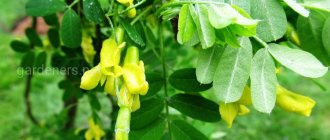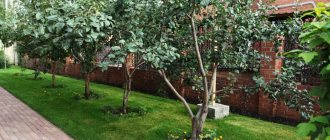Garden perennials have a number of advantages over annuals: there is no need to worry about planting every year, they are unpretentious, bloom for a long time, have a strong root system, and are resistant to weather troubles and frost. If you select tall species (height more than 80 cm), blooming in spring, summer, and autumn, you can create unusual bright corners on the site that will enliven the landscape until late autumn. Tall plants will support the structure of the flower garden and unite disparate compositions into a single whole.
Rogersia pinnate
Rogersia attracts gardeners with its ease of care, large size (stems can reach 1.5 m in height), and beautiful large leaves that come in different colors - from bronze to reddish-brown.
The main thing when caring for Rogers is to choose a suitable place. It is unlikely to like a sunny area: the perennial loves shade, and for normal growth it only needs a few hours of diffused sunlight throughout the day. Rogersia also needs moisture, but we do not recommend planting the plant in lowlands, because due to stagnation of liquid and constant waterlogging, rot may begin to develop.
The perennial blooms in summer for 1-1.5 months. The color of the inflorescences of different types of Rogers differs: small fragrant flowers can be white, pink, yellow, or red. After flowering ends, foliage begins to grow vigorously.
Rogersia can tolerate temperatures down to -25°C, but it is better to play it safe and mulch the soil around the plant in the fall. In this case, in the spring you will see your perennial healthy again.
Lilac
The branches of the plant reach a height of 4 meters. In May, the shoots are covered with fluffy inflorescences of purple, white, lilac, and pink colors. The flowers give off a pleasant floral aroma. Lilac does not require special attention.
The main thing that the gardener needs to do is, after the buds have dried, cut off the branches with inflorescences that have lost their decorative appearance. If this is not done, few flowers may form next season.
Note! After flowering, seeds begin to form, taking a lot of energy from the bush for its development. This is another reason why shoots are cut off in the summer.
Basilisk
Basil is found both in the wild and in summer cottages. The plant, which grows in the wild, has long been used as a medicine.
Decorative species differ in height: some do not grow higher than 20-25 cm, while others reach 1.5-1.7 m. Tall ones include water-leaved cornflower, yellow cornflower and Rochenbrunsky cornflower.
When planting cornflower, find a shady place with moist, fertile soil. It is advisable that it be protected from winds and drafts, because strong winds and rain can bend plants to the ground.
Loosestrife
Loosestrife is also called lily of the valley for its similar root system: in both plants it is superficial and grows quickly. For this reason, you need to carefully monitor the spread of loosestrife so that it does not displace other, less aggressive plants from the site.
Otherwise, this bushy perennial is unlikely to cause you any trouble. Plant it in moist, fertile soil and admire it throughout the growing season: in spring and autumn - the green and bright yellow crown, and in the summer - numerous white inflorescences with a drooping crown. The lush loosestrife bush grows to a height of approximately 1.3 m; It reaches approximately the same size in diameter.
Derain white
The following features add decorativeness to the bush:
- green leaves edged with a white stripe;
- spreading;
- corymbose white inflorescences;
- small fruits are first blue, then blue-white.
White derain adapts well to various conditions. It is often used as a hedge.
Meadowsweet (meadowsweet)
Many gardeners know meadowsweet under the name “meadowsweet”. This plant has been used in gardening since the 18th century. And this is not surprising, because the plant is unpretentious in care, blooms for a long time and beautifully, and is used in folk medicine.
Meadowsweet will grow well only if you plant it in a damp place: on the shore of a pond or in a lowland. Otherwise, you will have to water the plant frequently, otherwise the leaves will wither and the buds will fall off. Otherwise, care is simple: weeding and loosening. After flowering, in the fall, the meadowsweet needs to be trimmed, leaving 5-10 cm. The perennial does not need shelter: it is able to survive almost any winter.
The height of meadowsweet depends on the species. The tallest ones include red meadowsweet Venusta (1.5-2.5 m), red meadowsweet (1-1.7 m), red Magnifica (up to 1.7 m) and one of the tallest species - Kamchatka meadowsweet (1.2- 3m).
Astilbe
Astilbe
The most luxurious plant for a shady garden. It is attractive with its bright tall panicles of different colors and shades and beautiful openwork foliage. Any shady flower garden will benefit from its presence. Bright clumps of astilbe will prevent a shady corner from becoming neglected and, on the contrary, will attract attention to it. Astilbe is easily propagated by dividing the bush, so the issue of planting material is resolved easily and simply. All that remains is to select plants of the desired shades with different flowering periods and admire the result all season long.
Related article: Perennial flower astilbe
Buzulnik
Another tall plant that can decorate your garden is buzulnik (its other name is ligularia). Most varieties of buzulnik are low or medium-growing plants. However, there is one species - Vicha buzulnik, which reaches a height of 2 m. Its yellow pyramidal inflorescences will delight you with their beauty for 1.5 months, starting in August.
The plant prefers moist, shaded areas protected from drafts. The buzulnik will feel best on the shore of a reservoir. If you choose a good place for it, the plant can survive without replanting for 15-20 years. Buzulnik is not picky about soil fertility, diseases and pests bypass it, this perennial doesn’t care about most frosts - in a word, it’s an excellent choice for a novice summer resident or gardener who cannot devote much time to his pets.
- How to choose buzulnik - all about varieties and types
An elegant herbaceous perennial that can become a bright accent in your flower garden.
Spring tall flowers for the garden
Most tall perennials only gain strength in the spring, and their peak flowering occurs in summer or autumn. There are few of them that bloom in spring, but deciduous species are no less interesting - their original foliage makes them decorative.
Basil foliage (Thalictrum aquilegiifolium)
An interesting popular type of cornflower with a compact bush, reaching a height of 1.2 m. The leaf is beautiful, openwork, with a bluish tint. In May, fluffy pink or purple flowers bloom, collected in a corymbose panicle, then interesting leaflet fruits with original hooks are formed.
Darmera peltata
Darmera is decorative, for the most part, due to large bright green long-petioled (from 20 to 150 cm) leaf plates, which change color to copper-red in the fall. A wide (diameter 10-90 cm) sheet can be compared to an umbrella turned inside out.
Related article:
9 features of growing dahlias
It begins to bloom in mid to late spring before the leaves appear. Small pale pink flowers bloom on a pubescent peduncle (15-20 cm), forming a shield-shaped inflorescence. The peculiarity of the crop is that it grows slowly, prefers moist soils, so it is planted next to ponds, shade-tolerant crops, in the openwork partial shade of trees and shrubs.
Foxglove or purple foxglove (Digitalis purpurea)
Straight, rigid stems are tall (1-2 m), pubescent, without lateral shoots. The petiolate and lower leaves (length 25-30 cm) form a rosette at the root, the upper stem leaves are sessile. The leaf is smooth, dark green on top, the underside is pubescent, silvery in color.
Bell-shaped white, pink, purple lilac corolla drooping, tall spike-shaped inflorescence. In warm climates it begins to bloom in May, in temperate climates - in June. Most often, the flower is grown as a biennial crop - seedlings are planted in the fall, and flowering occurs the following year. The location is chosen in areas with nutritious loose soils, where there is slight shade or partial shade. Feature - after the seeds ripen, the leaf dies.
If children walk in the area, you need to be careful - the plant is poisonous.
Common species, varieties: Dwarf Sensation, Excelsior Hybrids, Gloxinioides, Sutton's Apricot, f. albiflora
Stockrose (mallow)
Stockrose has been known to everyone since childhood, when this flower towered above the others, perhaps in every front garden. Many people call it “mallow”, but they are different plants. One of the differences is that hollyhock is almost always a perennial, while hollyhock is an annual. And the stockrose is larger in height - it easily grows up to 2 m.
Blooms for a long time - from early summer to late autumn. The plant does not need special care. For the flower garden, choose a sunny (or slightly shaded) place away from drafts. Strong winds can cause tall stems to break, so it is best to plant them near a wall or fence.
Nivyanik: photos and features of perennial
Nivyanik has many names: white chamomile, roman herb, popovnik, white flower. This flower is a frequent inhabitant of gardens and suburban areas. The perennial is characterized by high resistance to negative weather conditions (frost) and unpretentiousness. Timely removal of baskets that have already bloomed will extend the flowering time of this amazing meadow plant.
Considering the origin of the cornflower, it becomes clear that the perennial prefers open and sunny areas. It is better to avoid areas where water stagnates. Properly grown chamomile can survive without replanting for 5, and sometimes even 7 years.
Nivyanik is distinguished by its durability and unpretentiousness.
Volzhanka vulgare
Volzhanka vulgare (another name is aruncus dioecious) has been used to decorate gardens for almost 400 years. This perennial is an excellent option for those who are looking for shade-tolerant plants for their site. Volzhanka can not only grow in the shade - she feels even better there than in the sun. From the sun's rays, its leaves fade and change color from green to yellowish.
Volzhanka is a tall plant, it can reach 2 m. For this reason, it is often used as a background for shorter representatives of the flora. It is also suitable for single plantings. Without transplants, it can stay in one place for about 10 years. It does not make any special demands on the soil. Caring for Volzhanka will not cause you much trouble: in addition to standard weeding and loosening, immediately after flowering, cut off all the inflorescences, and on the eve of winter - all the stems, leaving 3-5 cm.
Hyacinths: planting in open ground and caring for perennials
Planting hyacinths and caring for them primarily comes down to the use of fertilizers.
To obtain large and full flowers, dry fertilizer is used, which is introduced into the soil immediately after the first shoots appear and the first loosening of the soil is done. Hyacinth: methods of propagation, planting and care (read more)
The second application of fertilizer is done during the period when the buds have formed. This time the fertilizer is supplied to the root in liquid form. The third time, replenishment is carried out after the hyacinths have bloomed. This type of plant has special watering requirements. Before the bulbs take root, do not allow the soil to dry out. The soil should remain moist. During the remaining period, when the sprouts are already visible, the watering procedure should be carried out on a regular basis, especially in dry weather.
The first time after planting, hyacinths must be watered abundantly.
Aconite
Aconite, better known as fighter, is a poisonous plant, and all its parts are poisonous. However, despite the danger, it is often used in decorative floriculture. Many species of aconite grow to a height of more than 1.5 m. The plant is bushy; flowers can be white, yellow, blue and purple. It is their beauty that makes gardeners forget about the risk and use this plant in the garden. Flowering begins in the second half of summer and lasts until October. To prolong it, promptly remove all wilted inflorescences.
The perennial grows well in partial shade and in a shady area, but does not tolerate waterlogging. To prevent the death of the plant, before planting, take care to remove excess moisture from its roots. Without replanting, aconite can grow in one place for many years, so feed it with mineral or organic fertilizers from time to time.
Macleay cordate
Another giant (up to 2.5 m in height) perennial plant is maclea (also known as bocconia). The flower received both names in honor of famous biologists. In nature it grows in tropical areas, but cultivated varieties can also develop in the middle zone. Plants adapted to our conditions are frost-resistant (they do not need shelter) and unpretentious. The main thing is to choose the right place for them. Fertilizing with organic fertilizers, moist but not overabundant soil, a sunny and wind-protected area - these are the prerequisites under which the maquea will show itself in all its glory on your site. However, remember that this perennial is quite aggressive. If the territory of its distribution is not limited, it can become the sole owner of your garden, displacing all its neighbors.
Kalina
The most beautiful variety of the crop is viburnum Buldenezh. The bush reaches a height of 2.5-3 meters.
In May, the branches are covered with large caps of snow-white inflorescences. They are so heavy that the shoots can hang to the ground. And although viburnum has no aroma, it can create an amazing landscape on the site.
Willow sunflower
It is not for nothing that the willow-leaved sunflower received its name: its flowers are like those of a traditional sunflower, and its narrow leaves resemble willow. Because of the flowers that look like little suns, the plant is also called helianthus - “sun flower”.
This perennial can reach a height of 2, and in suitable conditions, 3 m. It blooms in autumn, in October-November. Choose a sunny area for it, because even with partial shading, you won’t expect helianthus to bloom. Willow sunflower also needs good drainage: it tolerates drought easily, but waterlogging can be disastrous for it. If the plant is planted in an area open to all winds, then also take care of the support.
Otherwise, caring for helianthus will not cause any particular difficulties: weeding, loosening, a layer of mulch before the winter period. Diseases and pests avoid it.
We hope that some of the giant plants described will settle in your garden this year.
Forsythia
This is one of the early flowering shrubs. The plant received the name "weeping bell" for its cascading branches covered with yellow buds. Flowers on the shoots bloom even before the leaves bloom.
Plant forsythia in a sunny place. The shrub looks spectacular when planted alone against the background of a lawn.











